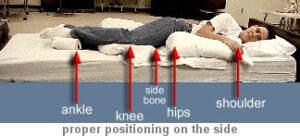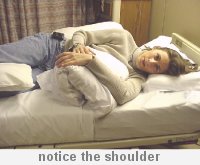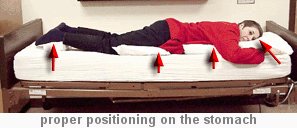Skin care with limited movement
After injuries that limit feeling and sensations, the skin will still protect the body, but there may be changes in some of its functions. The skin may not be able to tell a person if pain is present or if an injury to a limb has occurred, such as a burn, bruise, or cut. Lack of movement decreases blood flow to the skin which makes it less healthy and more apt to break down and turn into a sore.
When resting in bed, it is important to be properly positioned in order to protect the skin, muscles, and joints. Proper padding and positioning can promote range of motion, comfort, and rest, as well as prevent the skin from developing sores.
Resting on the back
- Support the head with a pillow.
- Put a foam pad under the heels so they do not touch the bed surface.
- Keep the feet from leaning on the bed’s footboard.
Foam pads may be placed above and below the sitting area. This technique, called bridging, takes pressure off the buttocks while lying in bed. It’s particularly helpful when sores are present on the sitting area.
Resting on the side

- Support the head with a pillow.
- Place a pillow behind the back for support.
- Place a pillow lengthwise between the legs. Do not let the knees or ankles touch each other while on one side.
- Place a foam pad between the ankles and between the bed and the ankle.
- Keep the feet from leaning on the footboard.
- Support the top arm with a pillow. Let the arm rest on top of the pillow.
The bridging technique can also be used on the side if necessary. For example, foam pads can be used above and below the hip area to protect that bony area while lying on the side. This is particularly helpful when sores are present on the hip area.
If you have been instructed to not rest on the side where the sore is present, follow the advice you were given by your therapist.
When on the side, the shoulder blade and arm should be moved forward by grabbing the shoulder blade and sliding it forward and out from underneath the person. Move the arm away from the body as you do this. Doing this promotes a more comfortable position for a person who cannot move their arm out of the way.
- Do not pull or jerk the arm out from the side.
- Support the top arm with a pillow. Let the arm rest on the pillow.


Resting on the stomach (proning)

- Support the head with a pillow.
- Place two or more pillows under the chest and thighs to keep pressure off the hips.
- Support the feet with pillows or foam pads to keep pressure off the tops of the feet.
Proning is a nice option for people who enjoy or can tolerate lying on the stomach. No turning through the night is necessary. Proning also straightens the hips and helps to prevent tightness in the hips and knees. You will want to change the position of the neck during the night, such as by turning the head from side to side, so it will not be stiff the next day.
Only try the prone position if suggested by your doctor or therapist, as it might be difficult for people with breathing problems.
